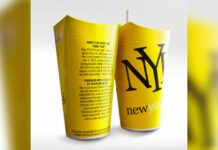By: Jennifer Febbraro
[dropcap size=big]T[/dropcap]he maple leaf on our Canadian flag could easily be swapped with a coffee cup silhouette, since Canadians are so passionate about their ‘cuppa Joe.’ In fact, according to the Toronto-based Coffee Association of Canada, our nation ranks
second only to Italy in terms of cups consumed outside of the home. “Great coffee is so
accessible these days that it just becomes a habit for the consumer to purchase it,” explains Sandy McAlpine, president of the Coffee Association of Canada. He adds: “Canada has proportionally more coffee-focused outlets per capita
than the U.S.”
Whether it’s the unbearably long winters or the need for a quick caffeine fix, Canadian consumers love to grab coffee on the go, and they don’t mind the occasional bump in price. The Chicago-based research firm Technomic’s 2014 Consumer Trend report shows that the average cup of coffee rose from $2.55 in 2012 to $2.77 in 2014, with nearly every other caffeinated drink — from teas to frozen or espresso-based coffees — also jumping in price by approximately 20 cents.
The NPD Group approximates the number of coffees consumed at foodservice operations to just about two-billion cups a year. “Canadians drink about two coffees per day on average,” says Robert Carter, executive director of the NPD Group, based in Toronto. “That breaks down to about 67 per cent of people brewing their java at home and 37 per cent buying their coffee at cafés or restaurants.”
So, home brewers have become the coffee industry’s next target audience. The popularity of single-cup brewing machines, an increasingly common wedding or graduation gift, has consumers searching for familiar brands in the supermarket aisles. This has led foodservice operators such as Tim Hortons and Starbucks to market retail product lines. And McDonald’s isn’t too far behind.
Tea consumption remains consistently lower at just under 500-million cups. In 2013, the NPD Group estimated that $415 million was spent on hot tea servings. However, large chains such as Starbucks and Tim Hortons are banking on that number to rise in the near future given a recent ‘long-range’ consumer report commissioned by Ottawa-based Agriculture and Agri-Food Canada on Canadian Food Trends. It states that tea consumption is expected to jump by 40 per cent by 2020. Researchers attribute cresting tea sales to consumer interest in health and wellness and their awareness of the benefits of various herbal fusions, particularly green tea, which has cleansing properties and purported healing benefits.
In the fight for every last customer, tea drinkers simply cannot be ignored. Nor should they be — as the NPD Group’s Carter notes that tea drinkers would rather simply have water than a substandard cup of tea. Perhaps, that’s why so many tea lovers opt to brew at home and to purchase their tea at stand-alone specialty shops such as Quebec-based Davids Tea or Teavana (most recently acquired by Starbucks). Teavana outlets are springing up everywhere, allowing for cross-branding opportunities for Starbucks.
As operators diversify their coffee and tea menus, Canadian consumers are reaping the benefits. Not only are their palates evolving with the premium quality of product offered, but consumers are becoming increasingly educated about their beverages in general. In turn, they are making even greater demands on operators and their suppliers. There’s been a huge push, for example, to offer free-trade coffees and teas that are not only affordable but also ethically harvested and sustainably grown. For example, Tim Hortons and Starbucks promote economically, socially and environmentally responsible coffee sourcing.
In an already saturated marketplace, it’s crucial that operators pay attention to trends or risk losing business. While customer loyalty remains durable, it’s easily lured astray by the newest, most authentic or free coffee just around the corner.
Tealicious
Tea purchases have been inching up a few per cent per year. The Toronto-based Tea Association of Canada has gauged the growth from 2013 to 2014 to be approximately four per cent. This makes tea the fastest-growing beverage category and the fifth most popular drink, according to the association. And while the Tea Association cites Earl Grey to be the most commonly ordered black tea in the foodservice industry, a recent 52-week study by Nielsen Research, which concluded in early 2014, shows green tea accounts for one quarter of total tea consumption in Canada.
In May, Tim Hortons took the beverage to a new level by creating a Frozen Green Tea and Raspberry Frozen Green Tea. “This is our first frozen-tea beverage in Canada,” enthuses Dave McKay, VP, Beverages, Tim Hortons. “We know Canadians love our frozen beverages, so this offers them a new twist on a flavour they know and love.”
According to Nielsen Research and the Tea Association of Canada, specialty teas are driving the market, outselling regular teas by almost 30 per cent. That’s why café and restaurant operators can no longer afford to make tea an afterthought to their focused and extensive coffee product development and marketing. As Canada witnesses more immigration from places such as Southeast Asia, India, China and the Middle East, where tea is a more popular drink than coffee, operators must ensure a selection of teas is on the menu.
Immigration plays a huge role in the demographics of the tea market. In January, Starbucks released a special, limited-time tea latte in celebration of the Chinese Year of the Horse; it was only available in China, Toronto and Vancouver since each of those cities has dense Chinese populations. The Blossoming Peach Tea Latte combined an aromatic, energizing blend of Earl Grey and peach flavour, which was inspired by a popular domestic tea developed in Starbucks cafés in China. Whipped cream and peach blossom sugar crystals gave the tea a dramatic, almost dessert-like presentation.
Starbucks’ expansion into the tea market shouldn’t come as a surprise. Its Chai Latte is a top-five seller in Canada and competes well alongside espresso-based specialty beverages. By purchasing Teavana for a cool $620 million in 2012, Starbucks has further established its commitment to the tea market. “We plan to do for tea what we have done for coffee through our Teavana expansion,” explains Carly Suppa, senior communications manager at Starbucks Coffee Canada, “especially with the launch of our Teavana Oprah Chai and most recently this summer, Teavana Shaken Iced Teas.” The seasonal hand-shaken drinks were available in five varieties, including Iced Green Tea with mint, lemongrass and lemon verbena. Suppa notes that Starbucks took Teavana from 59 points of distribution in Canada — which mostly existed within malls in cities such as Toronto, Vancouver and Montreal — to nearly 1,400 points of distribution in Starbucks company-owned and licensed stores across the country.
Looking to the future, Starbucks will offer a Teavana-curated, loose-leaf tea selection for a more enhanced tea experience. Combined with the already-popular Tazo tea at Starbucks, the company hopes to ‘infuse’ the marketplace and become the epicentre of specialty teas. Executives also hope to challenge some of the share taken by the aforementioned Davids Tea, a business with quirky tea flavours that has garnered a large following. A tea named “Movie Night,” for example, combines apple pieces, maple and popcorn and the Halloween-themed “Stormy Night” blends coconut, vanilla and chocolate. If the popularity of Davids Tea’s unusual brews proves anything, it’s that there’s no limit to how creative the beverage industry can get.
The Bean Supremacy
Thinking of pursuing that whimsical dream of opening a small café? Well, beware your competition. While Canadian consumers can’t seem to get enough java, big players such as Tim Hortons, Starbucks and McDonald’s make it all too easy to avoid the small neighbourhood cafés.
And all brands are feeling the crunch. May 2014’s Canadian Business magazine featured an interview with Marc Caira, president and CEO of Tim Hortons, in which he acknowledged the stiff competition in the coffee industry. When asked which competing operator made him nervous, Caira answered “Nervous is not a good quality in this job. The word I would use is ‘respect,’ and there are a number of competitors I really respect. I respect McDonald’s very, very much; a fantastic global brand.” But with more than 80 per cent of its restaurants in Canada and 90 per cent of its sales derived from the Canadian marketplace, Tim Hortons’ global expansion remains second to its commitment to the Canadian customer.
As Canada’s biggest quick-serve restaurant chain, the company reports a leading market share of 27 per cent in customer dollars and 42 per cent in customer traffic. To maintain steady growth and innovation, Tim Hortons has developed an “innovation council” and lab space to test new products, store formats and marketing campaigns. Despite its impressive 3,600 Canadian locations, 859 U.S. outlets and 38 stand-alone restaurants in the Persian Gulf, Caira says there’s always opportunities for expansion and has set a goal of opening at least 500 to 600 new Canadian restaurants in the next five years. He also speaks to more small-scale outlets such as kiosks. With the introduction of Tim TV and the new Double Double CIBC Visa cards, the company has expanded Tim Hortons’ culture by merging it with technological innovation.
Susan Bates, owner and operator of the Toronto-based Coffee Tree Roastery, admits that small-business owners must pay attention to the larger competition. “McDonald’s, like Starbucks, is a market leader, and we should all pay attention to what choices they make,” says Bates. “It trickles down and affects us all eventually, so pay close attention.” She doesn’t disparage the coffee and retail wars, but, rather, says it encourages operators to step up to the plate and offer the best product and menu possible. “Ultimately, it’s innovation and smarts that will decide who remains a key player down the line,” she says. “In the end, it’s the consumer who wins by getting a proliferation of menu choices and a great consistent product.”
Take McDonald’s strategy of giving away free coffee. Canadian Business magazine noted in an April article that, despite McDonald’s coffee sales tripling, its numbers didn’t come close to encroaching on Tim Hortons’ 77-per-cent market share. But, the customer still wins as the company continues pouring for free. Since April 2009, McDonald’s has given away 113-million cups of coffee.
Single Shots
Single-serve brewing systems are both innovative and disruptive to the coffee market. On the one hand, they allow customers to experience name brand coffee with just the push of a button; on the other hand, the single cups sell for less than an in-store purchase and could threaten in-store sales. According to a 2013 study by Nielsen Research, the Canadian single-serve market accounts for 22 per cent of the total roast and ground retail sales dollars. And that continues to grow in the double-digits annually.
For this reason, companies such as Tim Hortons, Starbucks and Second Cup have expanded into the K-cup market — as well as the pods, cartridges and other modes of packaging necessary for at-home, brewing-specific technologies.
The Coffee Association of Canada’s McAlpine says the brand extension phenomenon is a positive one. “Single-serve products offer a unique savings opportunity for the consumer, but also benefit retailers,” explains McAlpine.“The brands get the benefit of being on grocery store shelves, so they get to take on a new marketplace. But the consumer also gets the coffee they desire, at a lower price per cup.”
Though McDonald’s coffee has not yet arrived on Canadian supermarket retail shelves, an April 2014 article in Business Insider revealed that McCafé bagged coffee is on trial in U.S. supermarkets. The company is also testing single-serve cups. Unlike other operators, McDonald’s seeks to garner a cut of the $3.1-billion single-serve-pod market in the U.S.
Warm, chilled, frozen or frothed, coffee and tea flavours are being reborn in every imaginable format. And it’s a marketplace that continues to reinvent itself over and over again.

















